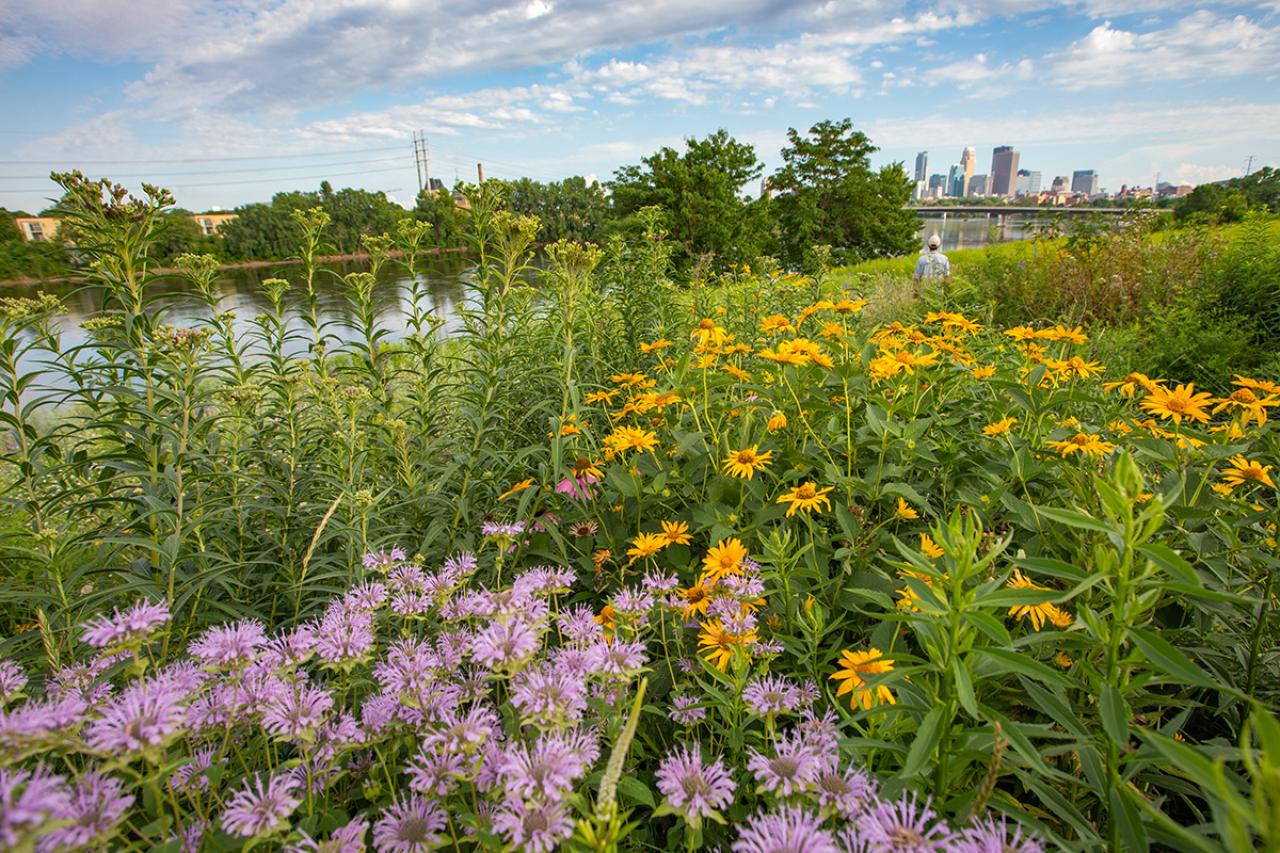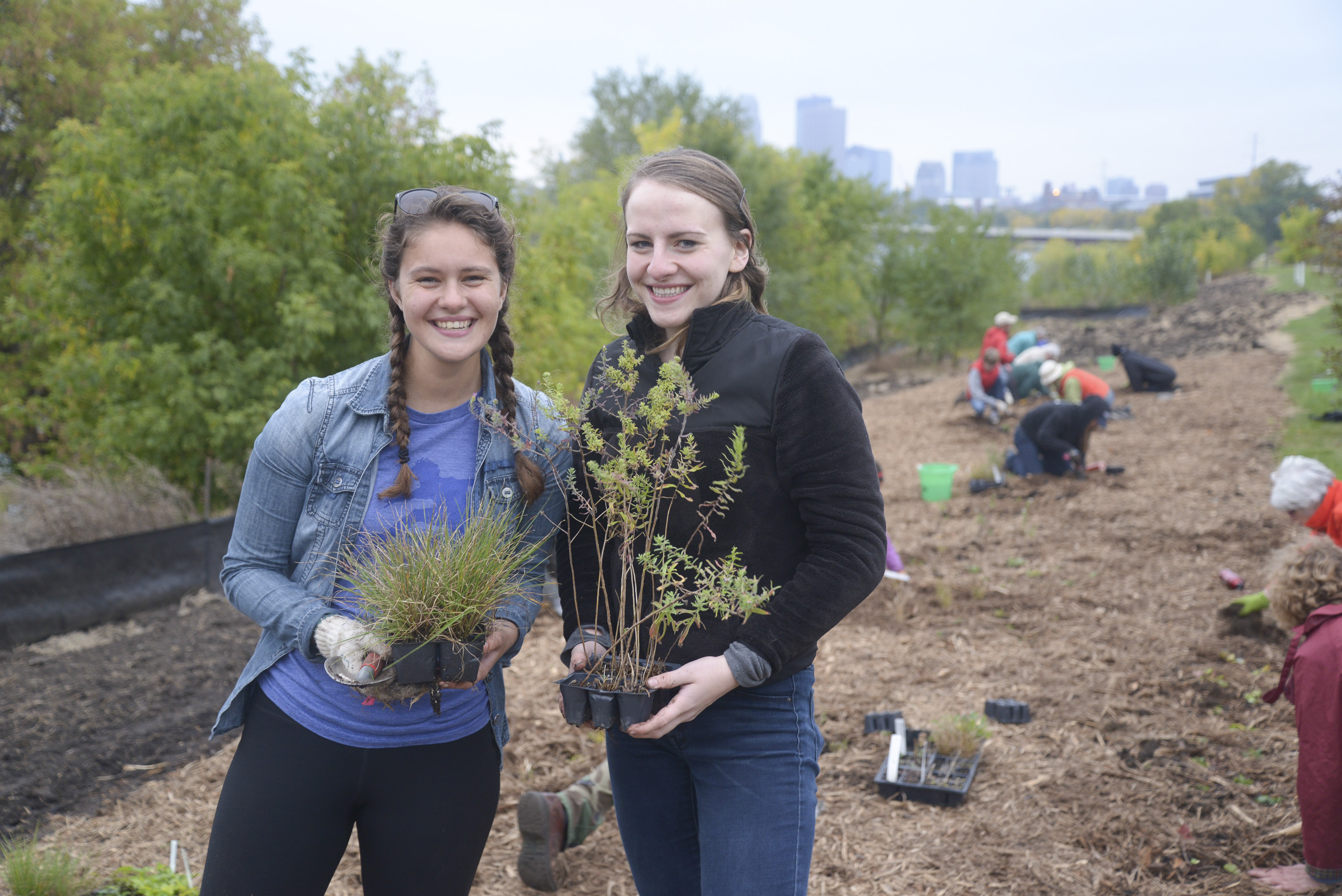Orvin 'Ole' Olson Park

Where is Ole Olson Park?
Orvin "Ole" Olson Park is a small Minneapolis riverfront park just north of Broadway Avenue in North Minneapolis. We're restoring 3.3 acres of riverside prairie there.
This park is just upriver from FMR's urban habitat restoration projects at Nicollet Island and Mississippi River Gorge Regional Park. Our volunteer-led stewardship project at James Rice Park is also just downstream.
The public is welcome to visit Orvin "Ole" Olson Park. (See the Minneapolis Park & Recreation Board website for more info.)
Our work takes place on Dakota homelands. Learn more.
What's special about Ole Olson Park?
Orvin "Ole" Olson Park in North Minneapolis is known for its top-notch walking and biking trails and stunning downtown Minneapolis skyline views. This spot is an FMR staff and volunteer favorite. Wildlife love it too! If you visit, keep your eyes out for our beloved "volunteer" beaver.
North of the Twin Cities, the Mississippi was once a prairie river, meaning that prairie and savanna communities grew right up to its banks. As agriculture grew in the north and industry advanced in and around the Twin Cities, much of that prairie habitat was lost. Although a small urban site, Ole Olson Park is a big step toward regaining some of that much-needed prairie habitat in an urban area.
Ole Olson Park is also home to a surprising variety of landscapes, including riverfront shoreline, woodland terrace and now, once again, a prairie thanks in large part to FMR's volunteers and supporters.

FMR volunteers have made our restoration work at Ole Olson Park possible. (Photo by Minneapolis Park & Recreation Board)
We know that even small patches of native habitat can be vitally important to pollinators and other rare or declining species. But these small patches are important for humans too. And as temperatures rise, natural areas like this will become even more important to keep our cities cool.
The restored prairie at Ole Olson Park reduces urban heat, as prairies stay up to 5 degrees cooler than surrounding concrete surfaces. Small prairies like the one at this site still provide this cooling effect. Read more about FMR's climate change and climate justice work.
Ole Olson Park is also one of the few parks with direct access to the Mississippi River in North Minneapolis, a historically and presently majority-Black community. Ole Olson Park is just across the street from the former site of the Riverview Supper Club, a longtime Black-owned nightclub, which closed in 2000. The Minneapolis Parks Foundation's RiverFirst plan promises to create more river access and connections for the Northside, including a trail along the river from Ole Olson Park to the 26th Avenue North Overlook by the fall of 2025.
Our work at Ole Olson Park
What was once a railyard, then a paint factory, a turfgrass field and then a thicket of invasive plants, Ole Olson Park is now a restored prairie in full bloom. The change from railyard to park happened over the span of more than a century, while the conversion of the site from turfgrass and invasive plants to native prairie has been in the works since 2015.
Before European colonization, prairie and savanna likely grew at what is now Ole Olson Park. When we began our restoration there, the park had connected people to the river but hadn't received much ecological attention. We found primarily invasive species, including grasses (smooth brome), forbs (birdsfoot trefoil, spotted knapweed, garlic mustard), shrubs (common buckthorn) and trees (Siberian elm).
So in the fall of 2015, crews removed invasive species and prepped the soil. In 2016, crews seeded the site with a native prairie mix, and volunteers installed a demonstration native prairie garden on the north end of the park. (Read more about the first year of restoration or check out our natural resources management plan for the area.)
Check out our video showing a prescribed burn at Ole Olson Park to aid the prairie restoration. We also made a video of the plants that bloomed afterward:
The 2,500-square foot native demonstration prairie garden along the bike trail serves not only as a showy centerpiece for our restoration, but also provides habitat for butterflies and other native pollinators that depend on native plant species. This pollinator patch includes over 30 different plant species, including 26 flowering species.
We've focused on diverse, pollinator-friendly restorations for many years. We design our plantings and seed mixes to include high-value pollinator plants with diverse heights, colors, and bloom times — all important when it comes to supporting a diverse community of pollinator species.
Projects like this make a significant impact for wildlife in our urban corridor. The flowers and grasses in this prairie restoration also beautify the park, and, with their deep roots, filter and reduce the amount of runoff and pollution flowing into the Mississippi River.

Pollinators enjoy wild bergamot, Culver's root, gray-headed coneflower and purple coneflower. (Left and right photos by Tom Reiter for FMR)
Find out more and get involved
- Volunteer with us to restore places like this or join the Above the Falls stewards. If you'd like to get notifications about volunteer events, sign up for our twice-monthly e-newsletter, Mississippi Messages.
- Explore some of FMR staff's favorite places upriver from St. Anthony Falls.
- Learn more about the power of small habitats.
- Plant for the river and wildlife at home.
- Contact FMR project lead Laura Domyancich-Lee.
Partners and funders for our work at Ole Olson Park
This work is made possible by BNSF Foundation, Fair State Brewing, Hennepin County, Marathon Foundation, Minneapolis Park & Recreation Board, the Minnesota Environment and Natural Resources Trust Fund as recommended by the Legislative-Citizen Commission on Minnesota Resources (LCCMR), Mississippi Watershed Management Organization, National Fish and Wildlife Foundation, RBC Wealth Management, SEA LIFE, Xcel Energy and by our generous donors like you!